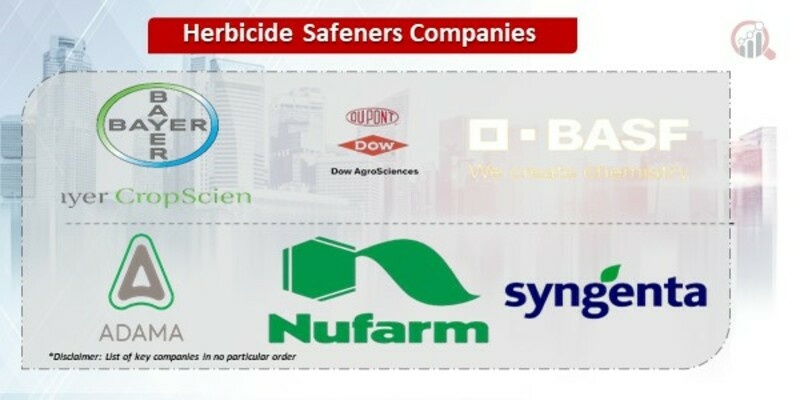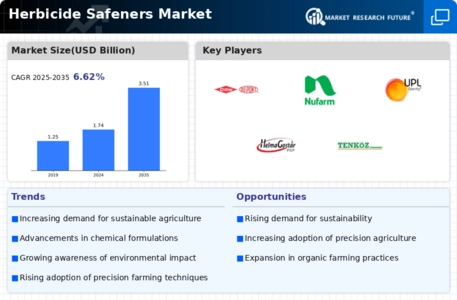Top Industry Leaders in the Herbicide Safeners Market

Competitive Landscape of Herbicide Safeners Market
Herbicide Safeners Market growth is driven by several factors, including rising herbicide adoption, increasing demand for crop yield improvement, and growing focus on sustainable agricultural practices. This dynamic landscape fosters a competitive environment with established players vying for market share alongside emerging entrants offering innovative solutions.
Strategies Adopted by Key Players:
- DowDuPont Inc. (US)
- BASF SE (Germany)
- Bayer AG (Germany)
- Syngenta AG (Switzerland)
- Nufarm Limited (Australia)
- Adama Agricultural Solutions (Israel)
- Arysta LifeScience (US)
- Drexel Chemical Company (US)
- Land O’Lakes (US)
- Sipcam-Oxon Group (Italy)
- Helm AG (Germany)
- Tenkoz (US)
- UPL Limited (India)
Strategies Adopted:
- Product Differentiation: Leading players invest heavily in R&D to develop safeners with broader crop compatibility, higher efficacy, and lower application rates. This focus on diversification helps them cater to specific needs within various crop segments.
- Geographical Expansion: Established players are entering emerging markets like Latin America and Asia Pacific, capitalizing on the rising demand for herbicide safeners driven by agricultural expansion in these regions.
- Strategic Partnerships and Acquisitions: Collaborations and acquisitions are becoming increasingly common, allowing companies to access new technologies, distribution channels, and geographical reach. For example, Syngenta's acquisition of Oxon Italia expanded its safener portfolio and strengthened its presence in Europe.
- Sustainability Focus: Sustainable agriculture practices are gaining prominence, leading to increased demand for eco-friendly safeners with reduced environmental impact. Companies are aligning their products and practices with this trend to gain a competitive edge.
Factors for Market Share Analysis:
- Product Portfolio Breadth and Efficacy: Companies with a wider range of safeners catering to diverse crops and offering superior weed control efficacy tend to hold a larger market share.
- Geographical Presence and Distribution Network: Strong presence in key agricultural regions and a robust distribution network are crucial for effective market penetration and reach.
- Brand Recognition and Reputation: Established brands with a strong reputation for quality and reliability hold an advantage in attracting customers and maintaining market share.
- Pricing and Cost Competitiveness: Offering competitive pricing strategies and cost-effective safener solutions can give companies a significant edge in price-sensitive markets.
New and Emerging Companies:
- Helm Agro US: With its recent EPA registration for Fearless, an atrazine-free acetochlor formulation with a premium safener, Helm is making waves in the corn herbicide market.
- Corteva Agriscience: Corteva is actively developing new safeners like pyrasulfone, targeting broadleaf weeds in corn and soybeans, aiming to expand its presence in the market.
- Drexel Chemical Company: Drexel's Tenkoz safener offers a unique solution for cotton weed control, positioning them as a niche player in a specific crop segment.
Industry News and Latest Updates
Technological Advancements:
- Development of bio-based herbicide safeners is gaining traction due to concerns about the environmental impact of synthetic chemicals. Companies like BASF and Bayer are investing in research and development of these eco-friendly alternatives.
- Precision agriculture technologies are being integrated with herbicide safener application to improve efficiency and reduce crop damage. This includes the use of drones and sensors for targeted application.
Regulatory Landscape:
- Stringent regulations regarding herbicide use and residue levels are driving the demand for safer and more effective herbicide safeners. This is particularly relevant in Europe and North America.
- Consolidation within the agrochemical industry is leading to mergers and acquisitions, which could impact the availability and pricing of herbicide safeners.
Recent News
- January 12, 2024: Syngenta announces the launch of its new herbicide safener, Synergy Z500, specifically designed for corn and soybeans. (Source: Syngenta press release)
- December 15, 2023: BASF and Corteva Agriscience collaborate on a research project to develop next-generation herbicide safeners with improved efficacy and environmental profile.
- November 22, 2023: The European Commission approves the use of a new herbicide safener, flufenacet, for maize and oilseed rape crops.

